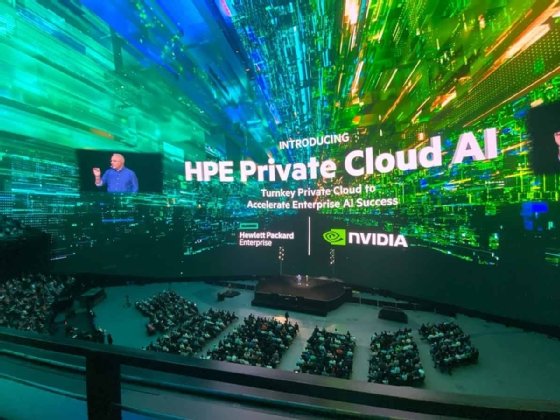HPE Discover 2024: Aruba Networking moves to center stage
HPE has made enterprise networking a critical part of its portfolio, with updates around AI, Aruba's networking tools, and the upcoming acquisition of Juniper.
HPE Discover 2024 in Las Vegas, which took place in June, was different in many ways from past events. AI was a central theme, which should be a surprise to absolutely no one. A more subtle difference that was nonetheless transformative for the networking sector was the merging of the HPE Aruba Atmosphere event into the Discover program.
That brought 2,500 networking attendees to this event, representing more than 210,000 members of the Aruba Airheads community. Airheads got a taste of the broader HPE strategy and portfolio, and the broader HPE user community more direct exposure to HPE networking products.
It was also a strong statement by HPE that networking is an essential aspect of enterprise IT going forward and there is high confidence that the HPE Aruba portfolio is a substantial foundation upon which to build. It lays the groundwork for the pending acquisition of Juniper Networks, which will turn networking products into a major pillar of HPE's overall business.
In the Atmosphere keynote, Phil Mottram, executive vice president and general manager of HPE Intelligent Edge/Aruba Networking, laid out the vision like this: "Aruba [is] delivering security-first, AI-powered networking, from the edge to the cloud, that is simple and easy for customers to manage."

The HPE Aruba team backed that up with product details on both the hardware and software side, some of which are currently available and some of which are coming in the next few months. A lot of it has to do with a string of acquisitions that HPE made in the first half of 2023. I found the following to be the most interesting.
Wireless networking
HPE Aruba was early to market in supporting Wi-Fi 7, with the new 730-Series access points announced back in April. Wi-Fi 7 introduces a 6 GHz band in addition to well-known 2.4 GHz and 5 GHz bands used in prior generations. HPE Aruba claims to have first-to-market capabilities for dynamically prioritizing and balancing application traffic across all three bands simultaneously, which it calls "ultra tri-band," coming out by the end of 2024.
Also interesting on the wireless networking front were improvements in location services, available now, for triangulating and tracking Wi-Fi and Bluetooth low-energy endpoints to 1-meter granularity in near real time. This is a five to ten times improvement in accuracy as compared to most other major wireless LAN vendors today. HPE's technology also tracks vertical location so you can determine which floor a device or user is on.
HPE also talked about another first -- its seamless approach to deploying combinations of Wi-Fi and private 5G (P5G) networks to cover challenging environments, such as ports, airports, manufacturing sites and educational campuses. HPE now handles dual deployments using Aruba Central and the Athonet platform, its P5G acquisition last year, utilizing HPE GreenLake services today, but plans to integrate P5G support into Aruba Central by next year.
Recent research from TechTarget's Enterprise Strategy Group indicated that integrated Wi-Fi and P5G management is considered highly desirable by those who are deploying P5G.
Networking AI
HPE also focused on networking for AI. This means upgrading network infrastructure capacity across the board in anticipation of AI workloads and related higher data volumes and density.
One of HPE Aruba's answers for this is the new 9300S high-performance 8 Terabit Ethernet data center switch, with 32 ports of 100 Gigabit Ethernet (GbE) and eight ports of 400 GbE. The 9300S can serve as either leaf or spine and intends to help make the transition from 25 GbE and 40 GbE to 100 GbE fabrics.
HPE also discussed a number of new capabilities coming later this year, in the form of generative AI assistants, automated security policy recommendations, network optimizers and even integrating digital experience management into Aruba Central.
OpsRamp
HPE, in its predecessor form as HP, was a longstanding leader in multivendor network monitoring and configuration management. Those products were spun off and now live on at OpenText. Since then, HPE has lacked a strategic replacement answer.
Enter OpsRamp, which HPE acquired last year. Since the acquisition, OpsRamp has emerged as a strategic platform for cross-domain integrated operations and observability within the HPE GreenLake portfolio, and it will be enhanced in two ways that are highly relevant to the networking community.
First, OpsRamp will integrate network traffic flow support, such as NetFlow, sFlow, IP Flow Importation Export and virtual private cloud flow logs, coming later this year. This is a big step toward comprehensive observability, as it's necessary to understand not only network health and the total volume of traffic -- which you can get with metrics collection -- but also what comprises the traffic loads. Traffic awareness opens the door for more definitive troubleshooting and a practical understanding of "what is," so corrective actions can be taken in context of actual application and service impact.
Second, later this year, OpsRamp will be integrated into Aruba Central to restore the latter's viability as a true multivendor network management platform. Legacy Aruba did have a product that fit this space, called AirWave, which is still in use by some customers today. With the new OpsRamp integration, there is now a roadmap for the future that integrates management across the full HPE Aruba Network portfolio as well as products from other networking vendors.
I would be remiss if I failed to note the "security first" storylines about how HPE Aruba is tightly integrating the security service edge (SSE) capabilities that came with the Axis Security acquisition, also last year. HPE has launched a fully integrated software-defined WAN/SSE integration already, as well as a local edge zero-trust network access offering. Upcoming later this year is "coffee shop networking" user experience for internet-only access and role-based dynamic segmentation.
Overall, these storylines put HPE Aruba Networking in a solid position in the marketplace, with an AI strategy for networking and a networking strategy for AI that is in tune with the current state of the market. The company is poised to push the envelope in key developing areas such as Wi-Fi 7, P5G and secure access networking. And of course, the elephant in the room is the pending Juniper acquisition, which will impact pretty much everything before HPE Discover happens again in 2025.
Jim Frey covers networking as principal analyst at TechTarget's Enterprise Strategy Group.
Enterprise Strategy Group is a division of TechTarget. Its analysts have business relationships with technology vendors.







